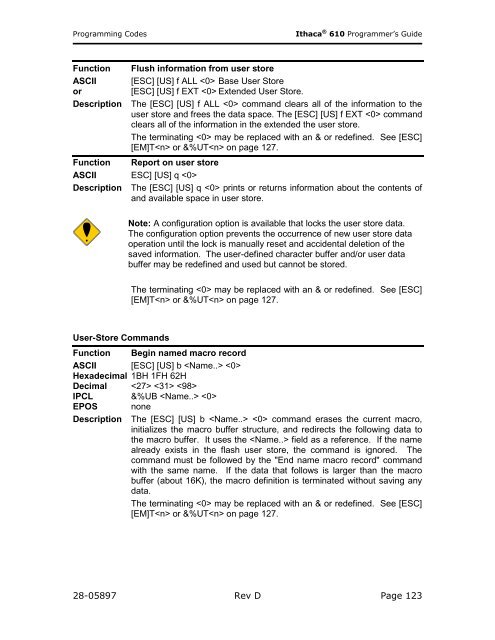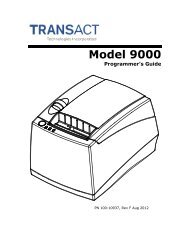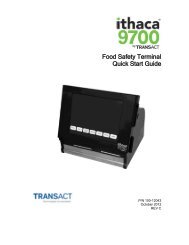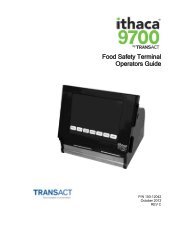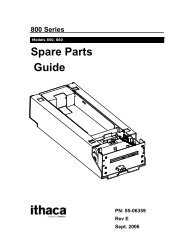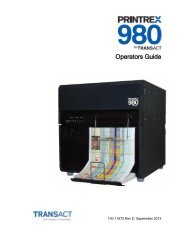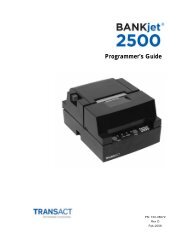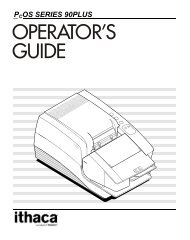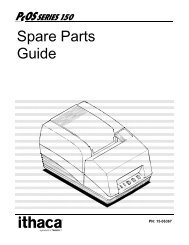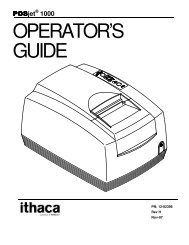- Page 1 and 2:
PN 28-05897 Rev D November 2010 Ith
- Page 3 and 4:
Federal Communications Commission R
- Page 5 and 6:
Table of Contents Change History ..
- Page 7 and 8:
Standard Emulation ................
- Page 9 and 10:
Figures Figure 1 Receipt Printing,
- Page 11:
28-05897 Rev D Page ix
- Page 14 and 15:
This page intentionally left blank
- Page 16 and 17:
About Your Ithaca ® 610 Printer It
- Page 18 and 19:
About Your Ithaca ® 610 Printer It
- Page 21 and 22:
chapter 2 Ithaca ® 610 Specificati
- Page 23 and 24:
Specifications and Requirements Ith
- Page 25 and 26:
Specifications and Requirements Ith
- Page 27 and 28:
Specifications and Requirements Ith
- Page 29 and 30:
Specifications and Requirements Ith
- Page 31 and 32:
Specifications and Requirements Ith
- Page 33 and 34:
Specifications and Requirements Ith
- Page 35 and 36:
Specifications and Requirements Ith
- Page 37 and 38:
Specifications and Requirements Ith
- Page 39 and 40:
Pin Number Direction Direction Dire
- Page 41 and 42:
chapter 3 Setup Procedures 28-05897
- Page 43 and 44:
Setup Procedures Ithaca ® 610 Prog
- Page 45 and 46:
Setup Procedures Ithaca ® 610 Prog
- Page 47 and 48:
Setup Procedures Ithaca ® 610 Prog
- Page 49:
Setup Procedures Ithaca ® 610 Prog
- Page 52 and 53:
This page intentionally left blank
- Page 54 and 55:
How to Operate the Ithaca ® 610 It
- Page 56 and 57:
How to Operate the Ithaca ® 610 It
- Page 58 and 59:
How to Operate the Ithaca ® 610 It
- Page 61 and 62:
chapter 5 Configuring Your Ithaca
- Page 63 and 64:
Configuring Your Ithaca ® 610 Prin
- Page 65 and 66:
Configuring Your Ithaca ® 610 Prin
- Page 67 and 68:
Configuring Your Ithaca ® 610 Prin
- Page 69:
Configuring Your Ithaca ® 610 Prin
- Page 72 and 73:
This page intentionally left blank
- Page 74 and 75:
Programming Codes Ithaca ® 610 Pro
- Page 76 and 77:
Programming Codes Ithaca ® 610 Pro
- Page 78 and 79:
Programming Codes Ithaca ® 610 Pro
- Page 80 and 81:
Programming Codes Ithaca ® 610 Pro
- Page 82 and 83:
Programming Codes Ithaca ® 610 Pro
- Page 84 and 85: Programming Codes Ithaca ® 610 Pro
- Page 86 and 87: Programming Codes Ithaca ® 610 Pro
- Page 88 and 89: Programming Codes Ithaca ® 610 Pro
- Page 90 and 91: Programming Codes Ithaca ® 610 Pro
- Page 92 and 93: Programming Codes Ithaca ® 610 Pro
- Page 94 and 95: Programming Codes Ithaca ® 610 Pro
- Page 96 and 97: Programming Codes Ithaca ® 610 Pro
- Page 98 and 99: Programming Codes Ithaca ® 610 Pro
- Page 100 and 101: Programming Codes Ithaca ® 610 Pro
- Page 102 and 103: Programming Codes Ithaca ® 610 Pro
- Page 104 and 105: Programming Codes Ithaca ® 610 Pro
- Page 106 and 107: Programming Codes Ithaca ® 610 Pro
- Page 108 and 109: Programming Codes Ithaca ® 610 Pro
- Page 110 and 111: Programming Codes Ithaca ® 610 Pro
- Page 112 and 113: Programming Codes Ithaca ® 610 Pro
- Page 114 and 115: Programming Codes Ithaca ® 610 Pro
- Page 116 and 117: Programming Codes Ithaca ® 610 Pro
- Page 118 and 119: Programming Codes Ithaca ® 610 Pro
- Page 120 and 121: Programming Codes Ithaca ® 610 Pro
- Page 122 and 123: B > > > > > C > > > > > D > > > > >
- Page 124 and 125: B > > > > > C > > > > > D > > > > >
- Page 126 and 127: Programming Codes Ithaca ® 610 Pro
- Page 128 and 129: Programming Codes Ithaca ® 610 Pro
- Page 130 and 131: Programming Codes Ithaca ® 610 Pro
- Page 132 and 133: Programming Codes Ithaca ® 610 Pro
- Page 136 and 137: Programming Codes Ithaca ® 610 Pro
- Page 138 and 139: Programming Codes Ithaca ® 610 Pro
- Page 140 and 141: Programming Codes Ithaca ® 610 Pro
- Page 142 and 143: Programming Codes Ithaca ® 610 Pro
- Page 144 and 145: Programming Codes Ithaca ® 610 Pro
- Page 146 and 147: Programming Codes Ithaca ® 610 Pro
- Page 148 and 149: Programming Codes Ithaca ® 610 Pro
- Page 150 and 151: Programming Codes Ithaca ® 610 Pro
- Page 152 and 153: Programming Codes Ithaca ® 610 Pro
- Page 154 and 155: Programming Codes Ithaca ® 610 Pro
- Page 156 and 157: Programming Codes Ithaca ® 610 Pro
- Page 158 and 159: Programming Codes Ithaca ® 610 Pro
- Page 160 and 161: Programming Codes Ithaca ® 610 Pro
- Page 162 and 163: Programming Codes Ithaca ® 610 Pro
- Page 164 and 165: Programming Codes Ithaca ® 610 Pro
- Page 166 and 167: Programming Codes Ithaca ® 610 Pro
- Page 168 and 169: Programming Codes Ithaca ® 610 Pro
- Page 170 and 171: Programming Codes Ithaca ® 610 Pro
- Page 172 and 173: Programming Codes Ithaca ® 610 Pro
- Page 174 and 175: Programming Codes Ithaca ® 610 Pro
- Page 176 and 177: Programming Codes Ithaca ® 610 Pro
- Page 178 and 179: Programming Codes Ithaca ® 610 Pro
- Page 180 and 181: Programming Codes Ithaca ® 610 Pro
- Page 182 and 183: Programming Codes Ithaca ® 610 Pro
- Page 184 and 185:
Programming Codes Ithaca ® 610 Pro
- Page 186 and 187:
Programming Codes Ithaca ® 610 Pro
- Page 188 and 189:
Programming Codes Ithaca ® 610 Pro
- Page 190 and 191:
Programming Codes Ithaca ® 610 Pro
- Page 192 and 193:
Programming Codes Ithaca ® 610 Pro
- Page 194 and 195:
Programming Codes Ithaca ® 610 Pro
- Page 196 and 197:
Programming Codes Ithaca ® 610 Pro
- Page 198 and 199:
Programming Codes Ithaca ® 610 Pro
- Page 200 and 201:
Programming Codes Ithaca ® 610 Pro
- Page 202 and 203:
Programming Codes Ithaca ® 610 Pro
- Page 204 and 205:
Programming Codes Ithaca ® 610 Pro
- Page 206 and 207:
Programming Codes Ithaca ® 610 Pro
- Page 208 and 209:
Programming Codes Ithaca ® 610 Pro
- Page 210 and 211:
Programming Codes Ithaca ® 610 Pro
- Page 212 and 213:
Programming Codes Ithaca ® 610 Pro
- Page 214 and 215:
Programming Codes Ithaca ® 610 Pro
- Page 216 and 217:
Programming Codes Ithaca ® 610 Pro
- Page 218 and 219:
Programming Codes Ithaca ® 610 Pro
- Page 220 and 221:
Programming Codes Ithaca ® 610 Pro
- Page 222 and 223:
Programming Codes Ithaca ® 610 Pro
- Page 224 and 225:
Programming Codes Ithaca ® 610 Pro
- Page 226 and 227:
Programming Codes Ithaca ® 610 Pro
- Page 228 and 229:
Programming Codes Ithaca ® 610 Pro
- Page 230 and 231:
Programming Codes Ithaca ® 610 Pro
- Page 232 and 233:
This page intentionally left blank
- Page 234 and 235:
Unicode Ithaca ® 610 Programmer’
- Page 236 and 237:
This page intentionally left blank
- Page 238 and 239:
Extended Control Codes Ithaca ® 61
- Page 241 and 242:
chapter 10 Communications 28-05897
- Page 243 and 244:
Communications Ithaca ® 610 Progra
- Page 245 and 246:
Communications Ithaca ® 610 Progra
- Page 247 and 248:
Communications Ithaca ® 610 Progra
- Page 249 and 250:
Communications Ithaca ® 610 Progra
- Page 251 and 252:
Communications Ithaca ® 610 Progra
- Page 253 and 254:
Communications Ithaca ® 610 Progra
- Page 255 and 256:
Communications Ithaca ® 610 Progra
- Page 257 and 258:
Communications Ithaca ® 610 Progra
- Page 259 and 260:
Communications Ithaca ® 610 Progra
- Page 261 and 262:
Communications Ithaca ® 610 Progra
- Page 263 and 264:
Communications Ithaca ® 610 Progra
- Page 265:
Communications Ithaca ® 610 Progra
- Page 268 and 269:
Appendix A: Code Page Definition Ta
- Page 271:
Appendix C: Ordering Supplies Ithac
- Page 274 and 275:
Index Ithaca ® 610 Programmer’s
- Page 276 and 277:
Index Ithaca ® 610 Programmer’s
- Page 278:
Index Ithaca ® 610 Programmer’s


